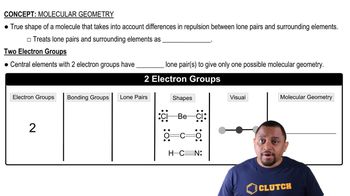Open Question
What is the molecular geometry of BrF5, and how can it be sketched using the bond conventions shown in 'Representing Molecular Geometries on Paper' in Section 10.4?
 Tro 4th Edition
Tro 4th Edition Ch.10 - Chemical Bonding II: Molecular Shapes & Valence Bond Theory
Ch.10 - Chemical Bonding II: Molecular Shapes & Valence Bond Theory Problem 31
Problem 31 Verified step by step guidance
Verified step by step guidance



A molecule with the formula AB3 has a trigonal planar geometry. How many electron groups are on the central atom?
For each molecular geometry, list the number of total electron groups, the number of bonding groups, and the number of lone pairs on the central atom. (c)
Determine the electron geometry, molecular geometry, and idealized bond angles for each molecule. In which cases do you expect deviations from the idealized bond angle? a. PF3 b. SBr2 c. CHCl3 d. CS2